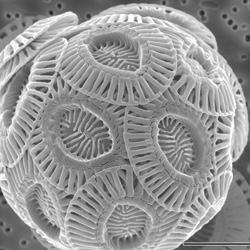Campus News
Climate more sensitive to carbon dioxide now than in past epochs
New evidence from the geologic record contrasts with today’s close coupling of climate and atmospheric carbon dioxide

Many studies of Earth’s climate history have documented a strong correlation between global climate and atmospheric carbon dioxide: during warm periods, high concentrations persist, and colder times correspond to relatively low levels. Now, however, paleoclimate researchers at the University of California, Santa Cruz, have found an exception to this pattern in the climate of the late Miocene, about 12 to 5 million years ago.
In the June 7 issue of Nature, the researchers present new evidence from deep-sea sediment cores revealing that the late Miocene climate was decoupled from atmospheric carbon dioxide concentrations. During this time, temperatures across a broad swath of the North Pacific were 5 to 8 degrees Celsius (9 to 14 degrees Fahrenheit) warmer than today, while atmospheric carbon dioxide concentrations remained low, near values on record just prior to the industrial revolution.
This new research shows that, in the past 5 million years, changes in ocean circulation caused the Earth’s climate to become more closely coupled to changes in carbon dioxide concentrations in the atmosphere. In other words, the climate of modern times more readily responds to changing carbon dioxide levels than it did earlier in Earth’s history.
The research team, led by UCSC graduate student Jonathan LaRiviere and Christina Ravelo, professor of ocean sciences, generated the first continuous reconstructions of open-ocean temperatures in the Pacific during the late Miocene epoch, a time of nearly ice-free conditions in the Northern Hemisphere and warmer-than-modern conditions throughout the continents. The work, which relies on microfossil evidence obtained by Ocean Drilling Program scientists on board the JOIDES Resolution, reveals a time when the Earth’s climate system functioned much differently than it does today.
“It’s a surprising finding, given our understanding that climate and carbon dioxide are strongly coupled to each other today. In the late Miocene, there must have been some other way for the world to be warm,” LaRiviere said. “One possibility is that large-scale patterns in ocean circulation, determined by the very different shape of the ocean basins at the time, allowed warm temperatures to persist despite low levels of carbon dioxide.”
The Pacific Ocean in the late Miocene was indeed very warm, and the thermocline, the boundary that separates warmer surface waters from cooler underlying water, extended much deeper than it does today. The authors suggest that this deep thermocline resulted in a distribution of atmospheric water vapor and clouds that could have maintained the warm global climate.
According to the study authors, several major differences in the world’s waterways could have contributed to the deep thermocline and the warm temperatures of the late Miocene. For example, the Central American Seaway separating North and South America remained open, the Indonesian Seaway was much wider than it is today, and the Bering Strait was closed. These differences in the boundaries of the world’s largest ocean, the Pacific, would have resulted in very different circulation patterns than those observed today.
By the onset of the Pliocene epoch, about 5 million years ago, the waterways and continents of the world had shifted into roughly the same positions they occupy today. This also coincides with a drop in average global temperatures, a shoaling of the thermocline, and the appearance of large ice sheets in the Northern Hemisphere; in short, the very climate that humans have known for all of recorded history.
“This study highlights the importance of ocean circulation in determining climate conditions. In addition, it tells us that the Earth’s climate system has evolved and that climate sensitivity is possibly at an all-time high today,” Ravelo said. “This means that the ocean and climate systems are poised to readily respond to even small changes in carbon dioxide.”
In addition to LaRiviere and Ravelo, the coauthors of the paper include UC Santa Cruz researchers Allison Crimmins, Petra Dekens, Heather Ford, and Michael Wara, and Mitch Lyle of Texas A&M University. This research was funded by the National Science Foundation.